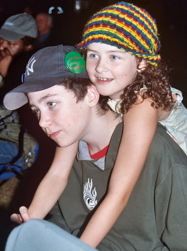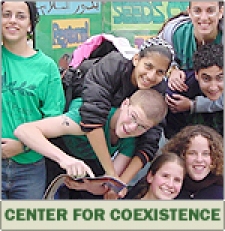From Treehugger comes a report about a yo-yo powered MP3 player. "The inventors estimate that between 10-12 tosses per hour are sufficient for continuous music play. A wireless headset allows the user to listen to music while yo-yoing." Cool.
Philippines Set Tree-Planting Record
A massive tree-planting campaign in the Philippines set a world record of a half million simultaneous plantings along highways. AP reports the participation was phenomenal proving citizen’s interest in cutting air pollution and beautifying the islands…
Inspiration Point: Teen Years are Some of the Best to Parents
 I am the director of The Natural Child Project , a psychologist, and author of The Natural Child: Parenting From the Heart. I envision a world where all children are treated with dignity, understanding, and compassion.
I am the director of The Natural Child Project , a psychologist, and author of The Natural Child: Parenting From the Heart. I envision a world where all children are treated with dignity, understanding, and compassion.
When asked about the notorious teen years I am often interrupted midway through my statement, "My son is 15 and has brought me nothing but …"
Judge Rules Bush’s Lax Pesticide Law Illegal
 A federal judge in Seattle yesterday overturned new Bush administration rules that weaken the governing of pesticide use and their effect on endangered plants and animals. The court struck down the EPA’s new rules and restored prior standards that provided greater protection to protected wildlife. The judge determined that the rules were “arbitrary and capricious” because they ignored the risks to species and because EPA political appointees ignored the unanimous concerns of its own scientists.
A federal judge in Seattle yesterday overturned new Bush administration rules that weaken the governing of pesticide use and their effect on endangered plants and animals. The court struck down the EPA’s new rules and restored prior standards that provided greater protection to protected wildlife. The judge determined that the rules were “arbitrary and capricious” because they ignored the risks to species and because EPA political appointees ignored the unanimous concerns of its own scientists.
Black Rhino Numbers Up 20 Percent
 Black rhino numbers are on the rise in Kenya after years of decline from poaching and habitat loss.
Black rhino numbers are on the rise in Kenya after years of decline from poaching and habitat loss.
According to officials, the country’s black rhino population has increased 20 percent, from 428 animals in 2003, to 539 animals at the end of 2005…
“This shows a healthy increase that surpassed our targets,” said Dr Taye Teferi, a Conservation Programme Director with the World Wildlife Fund, based in Nairobi. “Considering the intense poaching pressure and the demand for rhino horn, this is no mean achievement.”
The population growth is attributed to improved rhino protection, particularly through managing existing populations and ensuring that their habitats are suitable for foraging and reproducing.
WWF, through its black rhino project, is working with the Kenya Wildlife Service to increase Kenya’s black rhino population to 1,000 by 2020 through the expansion of existing rhino sanctuaries and through the establishment of new protected areas that can accommodate future population growth.
“With increased improvement in wildlife management and monitoring, the black rhino population can continue to show a healthy growth rate for many years to come,” added Dr Teferi. (WWF)
Disney Donates Endangered White Rhinos to Uganda
 To boost populations of white rhinos in their native Uganda, Disney’s Animal Kingdom in Florida sent two of the huge animals on a four-day journey to Africa where they walked on ancesteral soil for the first time. It is hoped the two will breed within a year in their new home, the Ziwa Rhino Sanctuary. (AP via Washington Post)
To boost populations of white rhinos in their native Uganda, Disney’s Animal Kingdom in Florida sent two of the huge animals on a four-day journey to Africa where they walked on ancesteral soil for the first time. It is hoped the two will breed within a year in their new home, the Ziwa Rhino Sanctuary. (AP via Washington Post)
Photo by Renaud Fulconis, rhinos-irf.org
Wetlands Restored After 107 Years
"Environmentalists who worked for 30 years to restore a massive California wetland area, watched as the ocean flowed into historic tidal basin Thursday for the first time in more than a century." Not many wetlands have been restored in the world, or in California, "where 95 percent of saltwater marshes have been given over to development." (AP via CBS News)
College Campuses are Going Green
In the state of Washington, colleges are now competing to see which school can become a better friend to the environment. By composting in cafeterias, using solar energy and recycling, faculties at universities are leading the way to a greener future. UW students are even "exploring how to use cooking oil from campus eateries to fuel university cars." (Seattle P-I)
Katrina, Rita Create Unexpected Boom
Despite dire forecasts that Gulf Coast governors would have to slash state budgets in the wake of hurricanes Katrina and Rita one year ago, a new report finds that booming "hurricane economies" have fueled state revenue surpluses across the region. State revenues in hardest-hit Louisiana and Mississippi swelled since the storms…
Encouraging Results in Iraqi Police Recruiting
(Aug 22) More than 500 Iraqi men have joined the police in Anbar province — the most violent area of the Sunni Arab insurgency — in what military leaders called the most successful recruiting drive in the region ever by U.S. and Iraqi forces…
Million Solar Roofs Plan Signed by California Governor
Governor Arnold Schwarzenegger signed a bill Monday to expand his Solar Roofs initiative:
My ‘Million Solar Roofs Plan’ will provide 3,000 megawatts of additional clean energy and reduce the output of greenhouse gasses by three million tons, which is like taking one million cars off the road. (Central Valley Business Times)
Peace Camp Grows Friendship Between Middle Eastern Kids
 Hempstead, NY – If you were invited to sit down with your enemy for a cup of tea and discuss your conflicting views, would you do it? … More than 2,500 Israeli, Palestinian, Egyptian, Pakistani and Indian kids, among others, have done just that. In fact, they spent three weeks with their “enemies†at a summer camp in the United States arguing, understanding, and ultimately coming to respect the humanity behind every face – even the humanity of their enemies. The programme that makes this happen calls these youth, Seeds of Peace.
Hempstead, NY – If you were invited to sit down with your enemy for a cup of tea and discuss your conflicting views, would you do it? … More than 2,500 Israeli, Palestinian, Egyptian, Pakistani and Indian kids, among others, have done just that. In fact, they spent three weeks with their “enemies†at a summer camp in the United States arguing, understanding, and ultimately coming to respect the humanity behind every face – even the humanity of their enemies. The programme that makes this happen calls these youth, Seeds of Peace.
One Man’s Mission to Fight Terrorism and Build Peace One School at a Time
 Greg Mortenson is an anti-terrorism warrior in the Islamic strongholds of Afghanistan and Pakistan, and his main weapon is schools… “Americans are now learning that we can’t fight the war on terrorism with bombs, but with books,” said Mortenson, 48, founder of a movement that has built 55 schools in those two countries in the past 13 years, educating 24,000 children.
Greg Mortenson is an anti-terrorism warrior in the Islamic strongholds of Afghanistan and Pakistan, and his main weapon is schools… “Americans are now learning that we can’t fight the war on terrorism with bombs, but with books,” said Mortenson, 48, founder of a movement that has built 55 schools in those two countries in the past 13 years, educating 24,000 children.
I can’t think of a better cause for Americans to support. His Pennies for Peace raises money from American schoolkids by collecting pennies to build his schools. His new book is Three Cups of Tea: One Man’s Mission to Fight Terrorism and Build Nations One School at a Time.
Thumping Headache? Try Eating Curry
Eating curry may be a better cure for headaches than aspirin, according to new research (and effective, without the negative side effects of aspirin).
The active ingredient in aspirin, salicylic acid, occurs naturally in Indian food… Spices such as curry, cumin, turmeric and paprika are particularly rich sources of the ingredient. (The London Times)
Rebels in India End Attacks
After 27 years and 10,000 civilian deaths, the separatist group United Liberation Front of Asom announced Friday that it would stop attacking the forces of the Indian government, which had announced a unilateral cease-fire in the conflict Aug. 13. Peace talks are now being sought by both sides. (AP)
Scientists Flock to Test ‘Free Energy’ Magnetic Field Discovery
Sean McCarthy says that his small hi-tech firm in Dublin has hit upon a way of generating clean, free and constant energy from the interaction of magnetic fields. McCarthy bought a newspaper advertisement to challenge the global scientific community to test his ideas. Within 36 hours, more than 400 applications from scientists had arrived eager to perform experiments on the technology, which challenges fundamental scientific principles. (Scientific American)
Necessity Moves Armenians to Run Cars on Natural Gas
The ex-Soviet state Armenia is blazing a trail in the global quest to move to cleaner fuels… (Upwards of 20%) of vehicles in Armenia run on natural gas, which produces fewer harmful greenhouse gases than gasoline or diesel. "There are gas refueling stations on every corner." (Reuters)
Trapped Cat Tugs At Hearts Of Four Youths Who Rescue It
Frantic cries rose from a sewer drain that was quickly filling with water. Four boys found a cat hanging on for dear life. They couldn’t reach it by themselves but figured out a way to help. With a happy, but also a very surprising ending, this story will cheer all pet-lovers. (Arizona Central)
Eliminating Customer-Infuriating Plastic Clamshell Packaging
Great news about those horrible plastic shell encasements that seem to require super-human strength — and stabbing motion with scissors — to extract anything from their clutches. Costco will begin to use recycled cases that are easy to open, helpful for our environment and soothing of customers nerves. I LOVE Costco! (Treehugger has details, and photo of angry unwrapper)
Something Good About You
![]() Do you want to hear something good about yourself?
Do you want to hear something good about yourself?
From Netropolis Design in Australia comes the Automatic Flatterer. Just tell the web page your name and you get the opportunity to read all sorts of good things about yourself. (It’s true that despite all of our foibles, we really are good!)




















